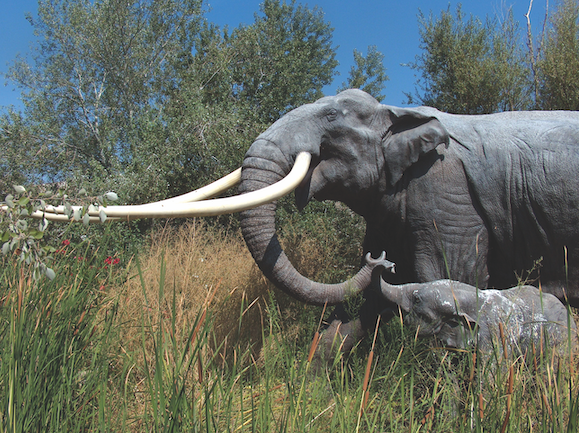Ice Age straight-tusked elephant and hippo bones found in Camden sewer
Highgate doc's discovery revealed in forthcoming London mammoth map
Friday, 19th August 2022 — By Tom Foot

A model of a straight-tusked elephant [apotea_CC BY-SA 3.0]
LUMBERING beasts of the Ice Age were discovered in Camden’s sewage system, according to archaeologists who are mapping Ice Age discoveries across north London.
The fragments of a straight-tusked elephant and a hippo had been held for years as exhibits in a dusty corner of the National History Museum.
They were found in “Brecknock Crescent” by a 19th-century collector and Highgate resident Dr Nathaniel Wetherall and have now come to light this week as part of a “London Mammoth map” created by experts at University College London in Bloomsbury.
Neanderthals expert Dr Matthew Pope told the New Journal: “It’s often said that you are likely to be six feet away from a rat in London. But I prefer to wonder how far might you be from a woolly mammoth?”
Dr Pope said the Ice Age spanned a “really long period of 2.7 million years” during which there were “regular cycles of climate change” that caused unusual animals to migrate to what is now Camden.
His colleague Dr Caroline Juby is credited with key research into the Ice Age “species discovered in Camden” including the straight-tusked elephant and hippo.
A letter accompanying the exhibits said: “The fragments were found by some men digging for a sewer on the side of the road leading from Holloway to Camden Town and near Brecknock Crescent.”
Brecknock Crescent no longer exists but old maps show it to be close to the current Brecknock Primary School. During colder spells of the Ice Age giant glaciers would advance down from the north and stretch across the whole of the country, destroying everything in its path.
Dr Pope said: “When the glaciers were advancing it was so cold that nothing much at all could live in London. But in the warmer cycles, which could last for 20,000 years, you would get hippos and straight-tusked elephants. Britain was connected to the continent at the time.”
Straight-tusked elephants could weigh up to 15 tonnes and roamed in herds of 15 or more. Bones from woolly mammoths have been found around Stoke Newington and are also listed on the map.
Despite their name, woolly mammoths were no bigger than your average elephant and some were comparable to a big dog, said Dr Pope.
He also revealed a bizarre but commonly known fact that the Ice Age glacier made it to London, finally resting around Finchley Road and Highgate.
“The furthest south the ice sheet ever gets is to north London – that’s around 450,000 years ago. As it moved forward the ice sheet chewed up all this rock across the Midlands and pushed it down towards, well it is quite specific, the top of Highgate.
“If you stood in Archway and looked north, you would have seen the ground rising up before you and at the top there were metres of ice. When it melts and collapses, all that water coming down… well, you can imagine the impact that had.”
Dr Pope explained he was “all about ancient humans” but was also aware of Ice Age hand axe discoveries made in Gray’s Inn Road, King’s Cross. Dr Pope said he hoped the Mammoth Map would help people “really look in our own back yard” and help people “find exciting stories in familiar process”.